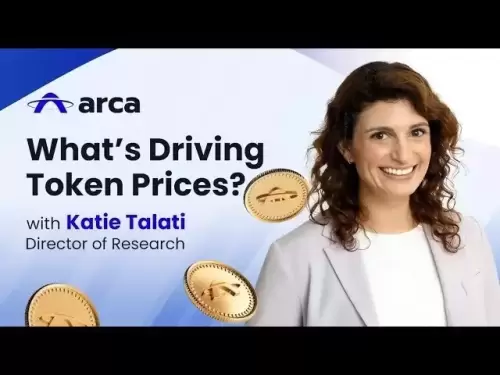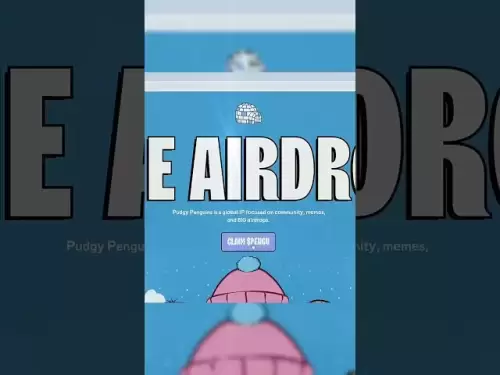-
 Bitcoin
Bitcoin $107,275.1551
-0.32% -
 Ethereum
Ethereum $2,485.3056
1.77% -
 Tether USDt
Tether USDt $1.0005
0.03% -
 XRP
XRP $2.2223
1.31% -
 BNB
BNB $657.7608
1.39% -
 Solana
Solana $156.3566
3.02% -
 USDC
USDC $0.9999
0.01% -
 TRON
TRON $0.2791
1.09% -
 Dogecoin
Dogecoin $0.1651
0.45% -
 Cardano
Cardano $0.5738
2.78% -
 Hyperliquid
Hyperliquid $40.2672
5.82% -
 Bitcoin Cash
Bitcoin Cash $517.5487
5.30% -
 Sui
Sui $2.7981
-0.40% -
 Chainlink
Chainlink $13.3500
-0.36% -
 UNUS SED LEO
UNUS SED LEO $9.1220
1.12% -
 Avalanche
Avalanche $17.9515
-0.32% -
 Stellar
Stellar $0.2361
-0.44% -
 Toncoin
Toncoin $2.9423
2.33% -
 Shiba Inu
Shiba Inu $0.0...01145
-0.68% -
 Litecoin
Litecoin $86.1693
-0.63% -
 Hedera
Hedera $0.1493
0.64% -
 Monero
Monero $315.1374
1.81% -
 Polkadot
Polkadot $3.4002
-0.73% -
 Dai
Dai $1.0001
0.03% -
 Bitget Token
Bitget Token $4.5413
-1.35% -
 Ethena USDe
Ethena USDe $1.0002
-0.01% -
 Uniswap
Uniswap $7.1733
-0.57% -
 Aave
Aave $274.0465
-0.23% -
 Pepe
Pepe $0.0...09810
2.24% -
 Pi
Pi $0.5101
-3.10%
What is the cross-chain capability of Sol coin?
Solana lacks native cross-chain support, relying instead on third-party bridges for interoperability with other blockchains. These bridges, while offering connectivity, introduce security and efficiency risks users must carefully consider.
Mar 14, 2025 at 01:55 am

Key Points:
- Solana's cross-chain capabilities are primarily achieved through bridges, not native functionality.
- Several bridges connect Solana to other blockchains like Ethereum, enabling token transfers.
- These bridges vary in security and efficiency, with risks inherent in using them.
- Solana's future development might incorporate more sophisticated cross-chain solutions.
- Understanding the limitations and risks associated with cross-chain bridges is crucial for users.
What is the cross-chain capability of Sol coin?
Solana, while known for its high transaction throughput, doesn't natively support cross-chain transactions in the same way some other blockchains might. This means Solana doesn't have a built-in mechanism to directly interact with other networks like Ethereum or Bitcoin. Instead, Solana relies on third-party bridges to facilitate cross-chain transfers. These bridges act as intermediaries, transferring assets between Solana and other blockchains. The security and functionality of these bridges vary greatly.
The absence of native cross-chain functionality is a significant point to consider. While Solana’s speed and scalability are advantages, the reliance on external bridges introduces potential vulnerabilities and complexities that users must understand. The need to use a bridge adds an extra step to the process, potentially increasing transaction fees and time. Moreover, the security of the bridge itself is paramount, as any compromise could lead to the loss of assets.
Numerous bridges currently facilitate transfers between Solana and other prominent networks. These bridges utilize various methods, such as locked assets or wrapped tokens. For example, a user might lock their ETH on Ethereum and receive an equivalent amount of wrapped ETH (wETH) on Solana. The bridge then acts as a custodian, ensuring the correct exchange rate and asset availability. However, the security of these custodial solutions relies entirely on the bridge's implementation and management.
One crucial aspect to remember is that different bridges operate with different levels of security and efficiency. Some bridges are decentralized, distributing trust among multiple validators, while others are centralized, relying on a single entity. Decentralized bridges, while offering greater security, may be slower and more expensive than centralized alternatives. The choice of bridge depends largely on the user's risk tolerance and the urgency of the transfer.
The process of transferring tokens across chains using a bridge typically involves several steps. It's not a simple, single transaction like an on-chain transfer. Understanding this process is vital to avoid mistakes and potential losses.
- Step 1: Selecting a Bridge: Choose a reputable bridge compatible with both the sending and receiving blockchains. Research its security measures and user reviews.
- Step 2: Approving Transactions: Approve the necessary transactions on both the source and destination chains. This usually involves paying gas fees on both networks.
- Step 3: Transferring Assets: Initiate the transfer, providing the necessary information such as recipient address and amount.
- Step 4: Claiming Assets: After the bridge processes the transaction, claim your assets on the destination blockchain. This might require an additional transaction.
It's essential to note that the security of cross-chain bridges is a constantly evolving area. Audits, upgrades, and new attack vectors continually challenge the robustness of these systems. Users should stay informed about any security vulnerabilities or incidents related to the bridges they intend to use. The development of more robust and secure cross-chain solutions is an ongoing process within the crypto space, and Solana's ecosystem is likely to see improvements in this area over time.
The limitations of relying on external bridges highlight the ongoing need for more sophisticated and integrated cross-chain solutions. While bridges offer a workable solution for now, they are not a perfect or entirely secure method for cross-chain interactions. Future advancements in cross-chain technology could offer more seamless and secure experiences for Solana users.
Frequently Asked Questions:
Q: Is Solana's lack of native cross-chain functionality a major drawback?
A: It depends on the user's priorities. While it's not ideal, the availability of numerous third-party bridges mitigates the issue to some extent. However, it does introduce complexities and security risks that native solutions would avoid.
Q: Are all cross-chain bridges for Solana equally secure?
A: No. Bridges vary significantly in their security architecture, ranging from centralized solutions to decentralized ones. Users must thoroughly research and choose bridges with a strong track record and robust security measures.
Q: What are the risks associated with using cross-chain bridges?
A: Risks include bridge vulnerabilities, scams, smart contract bugs, and the potential loss of funds due to errors or malicious actors. Careful due diligence is crucial.
Q: What is a wrapped token, and how does it relate to cross-chain transfers on Solana?
A: A wrapped token is a token representing an asset from another blockchain. For example, wETH represents ETH on the Solana blockchain. Wrapped tokens facilitate cross-chain transfers by creating a bridge between different networks.
Q: How can I minimize the risks when using cross-chain bridges for Solana?
A: Use reputable and well-audited bridges. Verify the bridge's security measures and check for community reviews. Start with small test transactions before transferring large amounts of assets.
Disclaimer:info@kdj.com
The information provided is not trading advice. kdj.com does not assume any responsibility for any investments made based on the information provided in this article. Cryptocurrencies are highly volatile and it is highly recommended that you invest with caution after thorough research!
If you believe that the content used on this website infringes your copyright, please contact us immediately (info@kdj.com) and we will delete it promptly.
- Coinbase, Altcoins, and Listings: What's the Buzz?
- 2025-07-01 00:30:11
- Chainlink's Bullish Signals: Investors Bet on Long-Term Value
- 2025-07-01 00:50:12
- CICADA Finance Soars on BNB Chain: A TGE Deep Dive
- 2025-07-01 01:30:11
- MicroStrategy's Bitcoin Bet: Holdings, Sell-Off Concerns, and S&P 500 Dreams
- 2025-07-01 01:30:11
- XRPL EVM Sidechain: Ethereum dApps Unleashed on XRP Ledger!
- 2025-07-01 01:35:11
- Bybit, Kraken, and Tokenized Stocks: A New Era for Trading?
- 2025-07-01 00:30:11
Related knowledge

How to customize USDT TRC20 mining fees? Flexible adjustment tutorial
Jun 13,2025 at 01:42am
Understanding USDT TRC20 Mining FeesMining fees on the TRON (TRC20) network are essential for processing transactions. Unlike Bitcoin or Ethereum, where miners directly validate transactions, TRON uses a delegated proof-of-stake (DPoS) mechanism. However, users still need to pay bandwidth and energy fees, which are collectively referred to as 'mining fe...

USDT TRC20 transaction is stuck? Solution summary
Jun 14,2025 at 11:15pm
Understanding USDT TRC20 TransactionsWhen users mention that a USDT TRC20 transaction is stuck, they typically refer to a situation where the transfer of Tether (USDT) on the TRON blockchain has not been confirmed for an extended period. This issue may arise due to various reasons such as network congestion, insufficient transaction fees, or wallet-rela...

How to cancel USDT TRC20 unconfirmed transactions? Operation guide
Jun 13,2025 at 11:01pm
Understanding USDT TRC20 Unconfirmed TransactionsWhen dealing with USDT TRC20 transactions, it’s crucial to understand what an unconfirmed transaction means. An unconfirmed transaction is one that has been broadcasted to the blockchain network but hasn’t yet been included in a block. This typically occurs due to low transaction fees or network congestio...

How to check USDT TRC20 balance? Introduction to multiple query methods
Jun 21,2025 at 02:42am
Understanding USDT TRC20 and Its ImportanceUSDT (Tether) is one of the most widely used stablecoins in the cryptocurrency market. It exists on multiple blockchain networks, including TRC20, which operates on the Tron (TRX) network. Checking your USDT TRC20 balance accurately is crucial for users who hold or transact with this asset. Whether you're sendi...

What to do if USDT TRC20 transfers are congested? Speed up trading skills
Jun 13,2025 at 09:56am
Understanding USDT TRC20 Transfer CongestionWhen transferring USDT TRC20, users may occasionally experience delays or congestion. This typically occurs due to network overload on the TRON blockchain, which hosts the TRC20 version of Tether. Unlike the ERC20 variant (which runs on Ethereum), TRC20 transactions are generally faster and cheaper, but during...

The relationship between USDT TRC20 and TRON chain: technical background analysis
Jun 12,2025 at 01:28pm
What is USDT TRC20?USDT TRC20 refers to the Tether (USDT) token issued on the TRON blockchain using the TRC-20 standard. Unlike the more commonly known ERC-20 version of USDT (which runs on Ethereum), the TRC-20 variant leverages the TRON network's infrastructure for faster and cheaper transactions. The emergence of this version came as part of Tether’s...

How to customize USDT TRC20 mining fees? Flexible adjustment tutorial
Jun 13,2025 at 01:42am
Understanding USDT TRC20 Mining FeesMining fees on the TRON (TRC20) network are essential for processing transactions. Unlike Bitcoin or Ethereum, where miners directly validate transactions, TRON uses a delegated proof-of-stake (DPoS) mechanism. However, users still need to pay bandwidth and energy fees, which are collectively referred to as 'mining fe...

USDT TRC20 transaction is stuck? Solution summary
Jun 14,2025 at 11:15pm
Understanding USDT TRC20 TransactionsWhen users mention that a USDT TRC20 transaction is stuck, they typically refer to a situation where the transfer of Tether (USDT) on the TRON blockchain has not been confirmed for an extended period. This issue may arise due to various reasons such as network congestion, insufficient transaction fees, or wallet-rela...

How to cancel USDT TRC20 unconfirmed transactions? Operation guide
Jun 13,2025 at 11:01pm
Understanding USDT TRC20 Unconfirmed TransactionsWhen dealing with USDT TRC20 transactions, it’s crucial to understand what an unconfirmed transaction means. An unconfirmed transaction is one that has been broadcasted to the blockchain network but hasn’t yet been included in a block. This typically occurs due to low transaction fees or network congestio...

How to check USDT TRC20 balance? Introduction to multiple query methods
Jun 21,2025 at 02:42am
Understanding USDT TRC20 and Its ImportanceUSDT (Tether) is one of the most widely used stablecoins in the cryptocurrency market. It exists on multiple blockchain networks, including TRC20, which operates on the Tron (TRX) network. Checking your USDT TRC20 balance accurately is crucial for users who hold or transact with this asset. Whether you're sendi...

What to do if USDT TRC20 transfers are congested? Speed up trading skills
Jun 13,2025 at 09:56am
Understanding USDT TRC20 Transfer CongestionWhen transferring USDT TRC20, users may occasionally experience delays or congestion. This typically occurs due to network overload on the TRON blockchain, which hosts the TRC20 version of Tether. Unlike the ERC20 variant (which runs on Ethereum), TRC20 transactions are generally faster and cheaper, but during...

The relationship between USDT TRC20 and TRON chain: technical background analysis
Jun 12,2025 at 01:28pm
What is USDT TRC20?USDT TRC20 refers to the Tether (USDT) token issued on the TRON blockchain using the TRC-20 standard. Unlike the more commonly known ERC-20 version of USDT (which runs on Ethereum), the TRC-20 variant leverages the TRON network's infrastructure for faster and cheaper transactions. The emergence of this version came as part of Tether’s...
See all articles

























































































